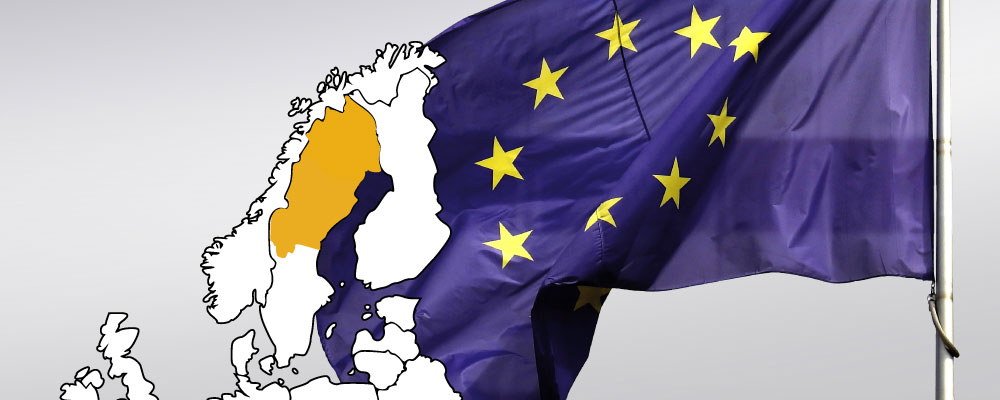The region
The North of Sweden is a diverse area with unique conditions for regional growth. It is an Arctic region with the EU's most sparsely population structure, but at the same time it has one of the EU's strongest innovation systems with attractive urban environments. The population is one of those with the highest average age in Europe, while the welfare system and quality of life are among the best in the EU.

Northern Sweden has unique conditions for growth and for welfare, hence North Sweden is active in the EU to ensure that the region has the best conditions for growth, with the help of EU regulations and funding opportunities. Northern Sweden faces specific challenges and has unique potential for development of the region while contributing to the development of the Union as a whole.
Remote sparsely populated urban regions in a global lead
Norrbotten, Västerbotten, Jämtland Härjedalen and Västernorrland are the EU's most sparsely populated territory with both extremely sparsely populated and more urban environments. Of the 900,000 inhabitants in the region, the majority live in cities along the Baltic Sea coast such as Luleå and Piteå in Norrbotten, Skellefteå and Umeå in Västerbotten as well as Örnsköldsvik, Härnösand and Sundsvall in Västernorrland. In other parts, the population structure is spread over a large inland geography with some population centers such as Kiruna in Norrbotten, Lycksele in Västerbotten and Östersund in Jämtland Härjedalen. This poses challenges in the form of sparse population structures, arctic conditions, low critical mass and long distances to markets that are turned into assets through smart investments and hard work.
Thanks to this approach, an extensive industry has developed that takes advantage of the unique conditions and confirm that the EU needs sparsely populated areas. The region is for example a test site for distance-bridging innovations, winter testing activities for the global automotive and wind power industry. The region is also host to the space base Esrange, which utilizes large land areas as a launching site for rockets and the low levels of light pollution for space research.
In the region, industries are being developed which utilize the reliable renewable energy, such as the heavy commodity sector and the process industry. Proximity to key raw materials, big land areas and the cold climate are assets for extensive activities with data centers in what can be called the base industry of digitization and electrification.
Traditional advanced industry joins new growing sectors
The regional economy is characterized by large natural resources in the form of forests, minerals and hydropower. 90% of EU's iron ore and a surplus of green electricity are produced in the region. As an effect of this, the region's industrial structure is largely based on a basic industry that consists of a number of Sweden's leading export companies. The heavy export-oriented industry places demands on a well-functioning infrastructure for transport within the regions, but also to the markets within and outside the EU.
With smart investments and an innovative climate, the base industries are in many fields world leading in productivity and sustainability. The region equip for the future with the development of bio-based products for a circular economy, the development of fossil-free steel production and methods for safe and sustainable mining with self-propelled and electrically powered machines.
The region has one of the EU's strongest innovation climate according to the EU's regional innovation scoreboard. The regional higher education institutions" Luleå University of Technology", "Umeå University" and the "Swedish University of Agricultural Sciences" in Umeå and "Mid Sweden University", have distinguished themselves internationally as well-rooted in the local business community strong contributors to renewal. At the same time, they, together with the institutes in the region, conduct world-leading research in areas such as biotechnology, energy and environmental technology, space technology, atmospheric science, medical technology and information and communication technology.
Collaboration creates attractive areas in the European Arctic
Northern Sweden also has large untouched nature areas that is somtimes called Europe's last wilderness. The mountains, forests and unique archipelago enable outdoor activities all year round, which is utilized by the region's tourist industry, and made available to the global market. The assets promotes unique values such as midnight sun, northern lights, wild-caught and locally produced food experiences and winter experiences that characterize the region.
Northern Sweden also offers world-class quality of life according to the EU Social Progress Index (SPI), which lists social factors that affect the living environment of EU citizens. Northern Sweden has a strategic position in the Barents region, which covers the northern counties of Norway, Sweden and Finland as well as parts of northwestern Russia, a region which is also termed the European Arctic. Through which a social and cultural exchange between the regions indigenous people's is conducted. This contributes to a good culture of cohesion in the region and also serves as a peace-promoting instance.
For the northern Sweden, the Sami are important actors in terms of economic, cultural and social activities and is of great importance for the region's historical cultural heritage. Despite, or perhaps due to the fact that the region is on the outskirts of Europe, Northern Sweden has extensive experience of international cooperation, close contacts and smart collaboration, which has been crucial for the economy in this sparsely populated environment. Today, there are equally close ties with northern Norway and northern Finland as with global players. As a result, many languages are spoken in the region - Swedish, Sami, Finnish and Meänkieli (Finish from Tornedalen).
The region, which is part of the EU's arctic territory, works actively to preserve and develop the economic, social and natural values that characterize the region.

